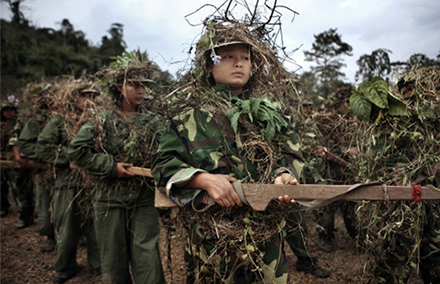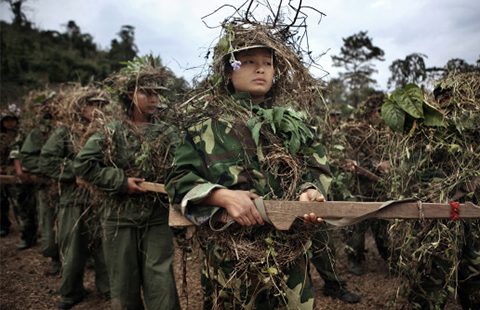
Kachin women undertaking military training. Photo by Adam Dean/ Sony World Photography Awards.
Too often we are blind to the gendered roots of violence and conflict in Myanmar.
Much of the focus on Myanmar’s ongoing political transformation and prospects for peace has centred on intrastate conflict and ethnic nationalism.
These analyses often frame military actors and institutions as key actors in the development of the country.
The roles and experiences of women in these conflicts have been largely left out of the picture – even though women’s labour and support is critical for sustaining the country’s ethnic war(s) against the state both in practical and ideological terms. As a result, both mainstream policy and academic studies are typically blind to the gendered roots of violence and conflict in Myanmar.
One clear example of this oversight is the ongoing battle between the Kachin Independence Army (KIA) and Myanmar’s leaders; one of the most persistent conflicts in the country.
My research suggests that women and men have difference experiences of, and reactions to, the conflict in Kachin state. These gender differences are material and visible in the high number of female-headed households in Kachin state compared to other areas of Myanmar.
They are also evident in the deliberate targeting of women for sexual violence by Myanmar’s Tatmadaw troops, and the paucity of women in formal peace talks.
It is precisely their gender-specific experiences of physical and material insecurity, including poverty, rape and discrimination, which lead women to support and participate in the armed struggle.
As such, women join or support the Kachin Independence Army for ideological and political reasons related to their position as members of a marginalised (ethnic and religious) group, as well as to their identity as women. This creates a connection between material conditions, political violence and gendered insecurity that needs to be unpacked.
An example of how insecurity is gendered can be seen in the number of female-headed households, or in the way that gendered norms work to position women as the caretakers of families. Being responsible for the survival of near and extended families means that women often lack the time and income to participate in public decision-making processes. In this way we see how gender, material insecurity at the household level, and political marginalisation all combine.
Being excluded from participating in political decision making processes of course impacts on women’s ability to have a voice and agency, which increases women’s insecurity. For example, the exclusion of women from local decision-making processes in some of the internally displaced persons camps’ committees means that the male experience has been applied as normative in the development and design of those camps. As a consequence, the toilets and the showers in the camps are not always sex segregated. This increases women’s insecurity.
Using the male experience as the norm means that women and men may be given the same amount of water and food in the camps, but gender standards mean that women do the majority of the cooking, cleaning and the washing of clothes in the camps, not men.
Because women need access to more water and more firewood than men, they end up leaving the camps to get more resources. But when they leave the camps, they are risk of being attacked by enemy soldiers or stepping on landmines. Here we can see how material insecurity at the household level interacts with political marginalisation at the level of local politics to increase women’s insecurity.
The use or even the threat of gender-based violence undermines women’s ability to participate effectively in public life and have a voice. For example, the threat of violence may mean that women won’t participate in political processes because they are unable to leave their homes or their communities. Such violence reinforces political marginalisation.
Despite that fact that many women experience sexual and gender based violence, there are no national level laws penalising domestic violence or marital rape. The constitution even includes a clause that effectively absolves the state military of any responsibility for crimes committed against women during conflict. This culture of impunity around violence increases women’s insecurity.
Insecurity is then clearly gendered, and women are responding to the gendered insecurity they experience by, for example, supporting or joining the KIA and Kachin Independence Organisation.
All female soldiers who I interviewed as part of my research explained their participation in the army as contributing to the survival and struggle for the Kachin nation. Most framed their involvement as related to nationalism, and positioned women as protectors of community. In fact, every woman I interviewed expressed a wish to fight on the frontlines alongside male soldiers
But despite these women’s wishes, they are prevented from taking up combat positions. By excluding women from combat, hetero-normative family values are maintained.
These values see women as the cultural and biological reproducers of the nation, but not as able to actually represent or protect the nation. Men are instead positioned as the primary defenders and protectors of both women and the community, writ-large.
Instead, women’s involvement in the conflict is typically structured around feminised duties, such as cooking, sewing and nursing, a gendered division of labour that serves to depoliticise women’s involvement. This depoliticisation is reinforced by the idea that women serving in the KIA should retire upon marriage in order to fulfil their duty to have children and take care of their home.
Women are therefore potential wives and mothers first, and soldiers second. This of course trivialises the fact that the armed struggle is dependent on women’s labour and participation. But also, as extensive military experience, including official combat experience, has been a de facto prerequisite for high-ranking political positions, the ability of most women to reach high-level positions in either the civilian or the military administration is severely circumscribed. This gendered division of labour means that women’s inclusion in the army does not actually upset the gendered status quo in any meaningful way.
It is therefore not enough to treat gender, conflict and insecurity as separate units of analysis. I think we must see women’s involvement within a context that is shaped by gendered inequality.
This then warrants an approach that links violence, insecurity, and socio-economic and political marginalisation in order to understand exactly how and why women are supporting the Kachin conflict, paying attention to the needs and objectives of Kachin women in general, and female soldiers in particular.
Women are important stakeholders in transitions from conflict to peace, and must be treated as such.
Jenny Hedström is a PhD student at Monash University. This article is based on a paper presented at the 2015 Myanmar/Burma Update held at the Australian National University.
 Facebook
Facebook  Twitter
Twitter  Soundcloud
Soundcloud  Youtube
Youtube  Rss
Rss 